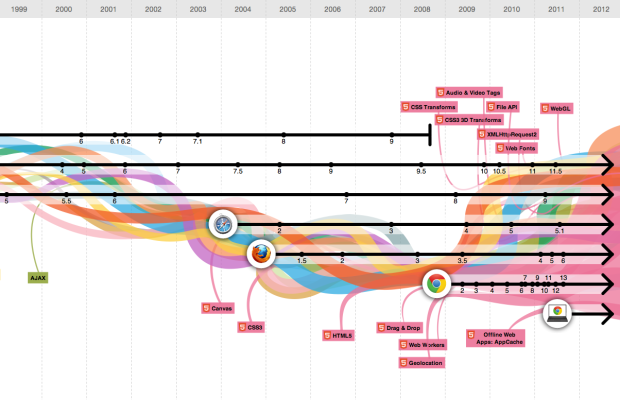In celebration of Chrome’s third birthday, Google teamed up with Hyperakt and Vizzuality to explore the evolution of the Web:
Over time web technologies have evolved to give web developers the ability to create new generations of useful and immersive web experiences. Today’s web is a result of the ongoing efforts of an open web community that helps define these web technologies, like HTML5, CSS3 and WebGL and ensure that they’re supported in all web browsers.
The black timelines show major browser releases. As you click each browser icon, you can see how the browser window has changed for each release, which I think is the most interesting part of the interactive.
Color bands represent browser technologies such as JavaScript, HTML, and Flash, and the bands grow as new browsers integrate the technologies. The intertwining of bands is supposed to show the interaction between different technologies, but it gets fuzzy here. Does the vertical position of bands mean anything? Does shape mean anything, or is it more for show? I think it’s a little of both. More the latter. Fun to poke around memory lane either way.
[Thanks, Deroy]



They are pretty heavy-handed in claiming-by-design that Chrome and Chrome OS are the future of the internetz. The width of the bands seems to denote how widely used each technology is (# of websites? users?), though the data do not seem to come from caniuse.com. Notice the utopian future past 2012 and the ubiquity of HTML5.
The position of the start of the bands leads you to assume that the closest browser best uses or was part of the invention of that technology. For example, on first glance you would think that only the Chromes can use Geolocation.
It’s a cool resource and beautifully designed. Their use of position and the term “evolution” lead me to question some of their motives…
It is pretty clear that this is less of a historical infographic and more of a marketing piece for HTML 5. Considering that there are no listed innovations between the introduction of the AJAX framework in 1999 and the first “HTML 5” method in 2004. I love Google, but they didn’t get where they are by being altruistic with the competition.
For my taste – too much spin, not enough data.